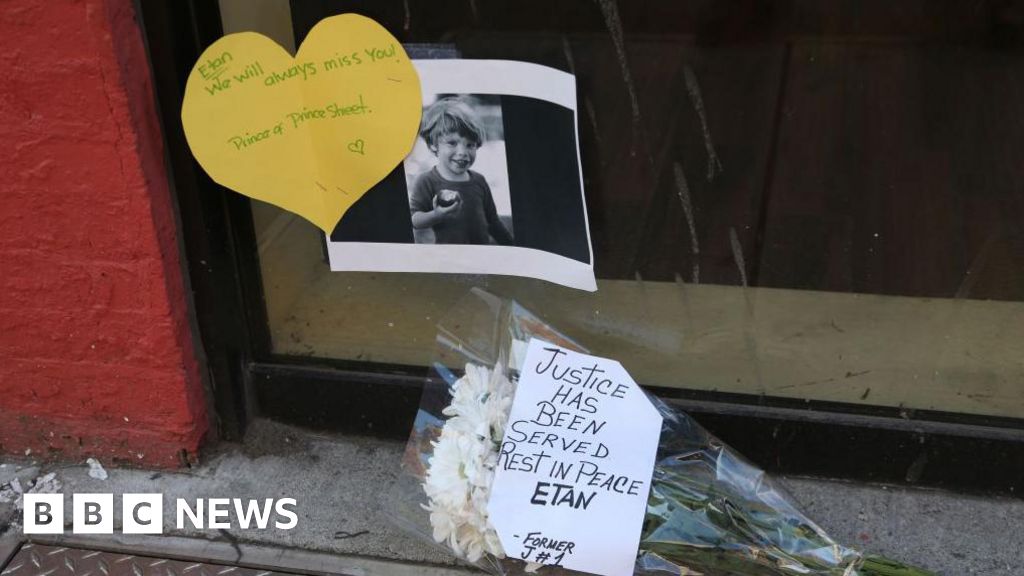Man convicted in 1979 kidnap and murder of Etan Patz must have new trial or be freed, appeals court rules – NBC News

Report on the Overturn of the Pedro Hernandez Conviction and its Alignment with Sustainable Development Goals
Executive Summary
A U.S. federal appeals court has overturned the 2017 conviction of Pedro Hernandez for the 1979 kidnapping and murder of Etan Patz. The ruling mandates a new trial or the release of Mr. Hernandez, citing a critical judicial error that compromised the fairness of the trial. This decision highlights the fundamental principles of the United Nations Sustainable Development Goals (SDGs), particularly SDG 16 (Peace, Justice and Strong Institutions), by reinforcing the rule of law, ensuring judicial accountability, and protecting the rights of vulnerable individuals within the justice system.
Case Background and Judicial Proceedings
The Disappearance of Etan Patz and its Social Impact
The case originates from the disappearance of 6-year-old Etan Patz in New York City on May 25, 1979. This event had a profound societal impact, catalyzing a national movement for missing children, famously symbolized by placing their photographs on milk cartons. This aspect of the case touches upon key development goals:
- SDG 11: Sustainable Cities and Communities: The crime underscored the critical need for safe urban environments (Target 11.7) where children can be secure.
- SDG 16: Peace, Justice and Strong Institutions: The incident represented a failure to protect children from violence (Target 16.2) and spurred institutional responses to combat such crimes.
Investigation, Confession, and Trials
Pedro Hernandez was convicted in 2017 after confessing to the crime in 2012. His legal proceedings were complex and raised significant questions regarding due process.
- Initial Interrogation: Mr. Hernandez, who has a documented history of mental illness and a low IQ, confessed after approximately seven hours of police questioning without having been read his Miranda rights.
- Videotaped Confessions: Subsequent confessions were videotaped after Miranda warnings were administered. These tapes formed the centerpiece of the prosecution’s case.
- Dual Trials: An initial trial in 2015 resulted in a hung jury. A second trial in 2016 led to a conviction for felony murder and kidnapping, with an acquittal on the charge of intentional murder.
Appellate Court Ruling: A Vindication of Due Process
Flawed Jury Instruction as Grounds for Reversal
The 2nd U.S. Circuit Court of Appeals based its decision on a flawed instruction given by the state trial judge to the jury. During deliberations, the jury asked whether they must disregard the later, videotaped confessions if they found the initial, un-Mirandized confession was not voluntary. The judge’s response, a simple “no” without explanation, was deemed a violation of established federal law.
Key Findings of the Court
- The trial court’s instruction contradicted clearly established federal law regarding the potential taint of subsequent confessions by an initial involuntary one.
- The judicial error was not harmless and had a substantial and injurious effect on the jury’s verdict.
- The ruling affirms that Mr. Hernandez must either be granted a new, constitutionally compliant trial or be released from custody.
Implications for Sustainable Development Goals
Upholding SDG 16: Peace, Justice and Strong Institutions
The appellate court’s decision is a powerful illustration of SDG 16 in action. It demonstrates a commitment to building effective, accountable, and inclusive institutions.
- Target 16.3 (Promote the rule of law and ensure equal access to justice): The ruling underscores that adherence to legal procedure, such as proper jury instruction and respect for Miranda rights, is non-negotiable for a just outcome. It champions the principle of equal access to justice, particularly for defendants with vulnerabilities that could be exploited during interrogation.
- Target 16.6 (Develop effective, accountable and transparent institutions): The appellate review process serves as a critical mechanism for accountability, correcting errors made at lower levels of the judiciary and ensuring the integrity of the legal system as a whole.
Intersection with SDG 3: Good Health and Well-being
The case brings to the forefront the justice system’s handling of individuals with mental health challenges, directly relating to SDG 3.
- Target 3.4 (Promote mental health and well-being): The circumstances of Mr. Hernandez’s confession, given his low IQ and history of mental illness, highlight the critical need for legal frameworks to protect the well-being and rights of cognitively and mentally vulnerable individuals, ensuring they are not subject to coercive interrogation tactics. This case serves as a precedent for ensuring that mental health is a key consideration in the pursuit of justice.
Analysis of Sustainable Development Goals (SDGs) in the Article
1. Which SDGs are addressed or connected to the issues highlighted in the article?
- SDG 16: Peace, Justice and Strong Institutions: This is the most prominent SDG in the article. The text revolves around the justice system, including a crime (kidnapping and murder), police interrogation, trials, a conviction, and an appeals court ruling. It directly addresses themes of violence, justice for victims, and the legal rights of the accused, which are central to SDG 16.
- SDG 3: Good Health and Well-being: The article connects to this goal through its repeated mention of the defendant’s mental health. It states that “Hernandez has a documented history of mental illnesses” and his lawyers have “argued that Hernandez is mentally ill.” This highlights the intersection of mental health and the justice system.
- SDG 10: Reduced Inequalities: This goal is relevant because the article discusses factors that can lead to unequal treatment within the justice system. The defendant is described as having a “low intelligence quotient (‘IQ’)” in addition to mental illness, making him a vulnerable individual. The legal challenge addresses whether the judicial process fairly accounted for these vulnerabilities.
2. What specific targets under those SDGs can be identified based on the article’s content?
-
Target 16.1: Significantly reduce all forms of violence and related death rates everywhere.
- The article is centered on a violent crime, specifically the “1979 kidnapping and murder of 6-year-old Etan Patz,” which directly relates to this target’s aim to reduce violence and death.
-
Target 16.2: End abuse, exploitation, trafficking and all forms of violence against and torture of children.
- The victim was a “6-year-old” child who was lured, kidnapped, and murdered. The case of Etan Patz is a stark example of the violence against children that this target seeks to eliminate.
-
Target 16.3: Promote the rule of law at the national and international levels and ensure equal access to justice for all.
- The entire legal proceeding described, from the initial trial to the appeal, is an exercise in the rule of law. The appeals court’s decision to overturn the conviction because the “state trial court contradicted clearly established federal law” is a direct action to promote the rule of law. The case also questions whether the defendant, due to his mental state and the nature of his interrogation, received “equal access to justice.”
-
Target 3.4: …promote mental health and well-being.
- The article highlights the defendant’s “documented history of mental illnesses” as a critical factor in the case. The legal arguments and the court’s consideration of his confession’s validity touch upon how the justice system accommodates and treats individuals with mental health conditions, which is an aspect of promoting overall well-being.
-
Target 10.3: Ensure equal opportunity and reduce inequalities of outcome, including by eliminating discriminatory… practices and promoting appropriate… action…
- The defendant’s vulnerability due to “mental illnesses and a low intelligence quotient (‘IQ’)” is a central theme. The appeals court’s ruling can be seen as an action to reduce an inequality of outcome, correcting a trial process where these vulnerabilities may not have been adequately protected, particularly concerning his “unwarned questioning” and subsequent confessions.
3. Are there any indicators mentioned or implied in the article that can be used to measure progress towards the identified targets?
- For Target 16.1 & 16.2: The article provides a specific instance of a violent crime and murder of a child (“kidnapping and murder of 6-year-old Etan Patz”). This case itself serves as a qualitative data point for indicators measuring intentional homicide and violence against children.
- For Target 16.3: The judicial review process is an implied indicator. The fact that the “2nd U.S. Circuit Court of Appeals overturned the conviction” because of a “flawed instruction” and a “clear violation of law” indicates a functioning system of checks and balances designed to uphold the rule of law. The defendant’s status, having been “in prison for more than 13 years” for a conviction now deemed unlawful, relates to indicators on detention and the fairness of legal proceedings.
- For Target 3.4: The explicit mention of the defendant’s “documented history of mental illnesses” serves as a direct indicator of mental health issues interacting with the justice system. The legal system’s response to this information is a measure of progress in integrating mental health considerations into judicial processes.
- For Target 10.3: The defendant’s “low intelligence quotient (‘IQ’)” is a specific indicator of a disability that could lead to unequal treatment. The court’s intervention, based on how his confessions were obtained and presented to the jury, is an indicator of action being taken to ensure equal opportunity and a fair outcome for vulnerable individuals in the justice system.
4. Table of SDGs, Targets, and Indicators
| SDGs | Targets | Indicators Identified in the Article |
|---|---|---|
| SDG 16: Peace, Justice and Strong Institutions |
16.1: Reduce all forms of violence and related death rates.
16.2: End abuse, exploitation, and all forms of violence against children. 16.3: Promote the rule of law and ensure equal access to justice. |
The specific case of the “kidnapping and murder of 6-year-old Etan Patz” serves as a qualitative instance of intentional homicide.
The crime detailed against a 6-year-old child is a direct example of violence against children. The overturning of a conviction due to a “flawed instruction” and violation of “clearly established federal law” indicates the functioning of the rule of law. |
| SDG 3: Good Health and Well-being | 3.4: Promote mental health and well-being. | The defendant’s “documented history of mental illnesses” is a direct mention of a mental health condition requiring consideration within the justice system. |
| SDG 10: Reduced Inequalities | 10.3: Ensure equal opportunity and reduce inequalities of outcome. | The defendant’s vulnerability due to “mental illnesses and a low intelligence quotient (‘IQ’)” is noted. The court’s action to overturn the conviction is an indicator of the system working to ensure a fair process for vulnerable individuals. |
Source: nbcnews.com

What is Your Reaction?
 Like
0
Like
0
 Dislike
0
Dislike
0
 Love
0
Love
0
 Funny
0
Funny
0
 Angry
0
Angry
0
 Sad
0
Sad
0
 Wow
0
Wow
0









































































